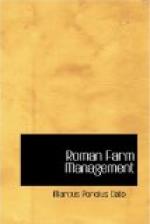At the beginning of the first Georgic (1-5) Virgil lays out the scope of the poem as dealing with three subjects, agriculture, the care of live stock and the husbandry of bees. This was Varro’s plan (R.R. I, I, 2, and I, 2 passim) except that under the third head Varro included, with bees, all the other kinds of stock which were usually kept at a Roman steading. Varro asserts that his was the first scientific classification of the subject ever made. Virgil (G. I, 5-13) begins too with the invocation of the Sun and the Moon and certain rural deities, as did Varro (R.R. I, I, 4). The passages should be compared for, as M. Gaston Boissier has pointed out, the difference in the point of view of the two men is here illustrated by the fact that Varro appeals to purely Roman deities, while Virgil invokes the literary gods of Greece. Following the Georgics through, one who has studied Varro will note other passages for which a suggestion may be found in Varro, usually in facts, but some times in thought and even in words, viz: Before beginning his agricultural operations a farmer should study the character of the country (G. I, 50: R.R. I, 6), the prevailing winds and the climate (G. I, 51: R.R. I, 2, 3), the farming practice of the neighbourhood (G. I, 52: R.R. I, 18, 7), “this land is fit for corn, that for vines, and the other for trees,” (G. I, 54: R.R. I, 6, 5). He should practise fallow and rotation (G. I, 71: R.R. I, 44, 2), and compensate the land by planting legumes (G. I, 74: R.R. I, 23); he should irrigate his meadows in summer (G. I, 104: R.R. I, 31, 5), and drain off surface water in winter (G. I, 113: R.R. I, 36). Man has progressed from a primitive state, when he subsisted on nuts and berries, to the domestication of animals and to agriculture (G. I, 121-159: R.R. II, 1, 3). The threshing floor must be protected from pests (G. I, 178: R.R. I, 51). Seed should be carefully selected (G. I, 197: R.R. 40, 2); the time for sowing grain is the autumn (G. I, 219: R.R. I, 34). “Everlasting night” prevails in the Arctic regions (G. I, 247: R.R. I, 2, 5); the importance to the farmer of the four seasons (G.I. 258; R.R. I, 27) and the influence of the Moon (G.I. 276: R.R. I, 37).
The several methods of propagating plants described (G. II, 9-34: R.R. I, 39), but here Varro follows Theophrastus (H.P. II, 1); trees grow slowly from seed (G. II, 57; R.R. I, 41, 4); olives are propagated from truncheons (G. II, 63; R.R. I, 41, 6). “The praise of Italy” (G. II, 136-176: R.R. I, 2, 6), where trees bear twice a year (G. II, 150: R.R. I, 7, 6). Certain plants affect certain soils (G. II, 177: R.R. I, 9). A physical experiment (G. II, 230; R.R. I, 7); the advantage of the quincunx in planting (G. II, 286: R.R. I, 7). Fence the vineyard to keep out live stock (G. II, 371: R.R. I, 14); the goat a proper sacrifice to Bacchus (G. II, 380: R.R. I, 2, 19). Be the first to put your vine props under cover (G. II, 409: R.R. I, 8, 6).




